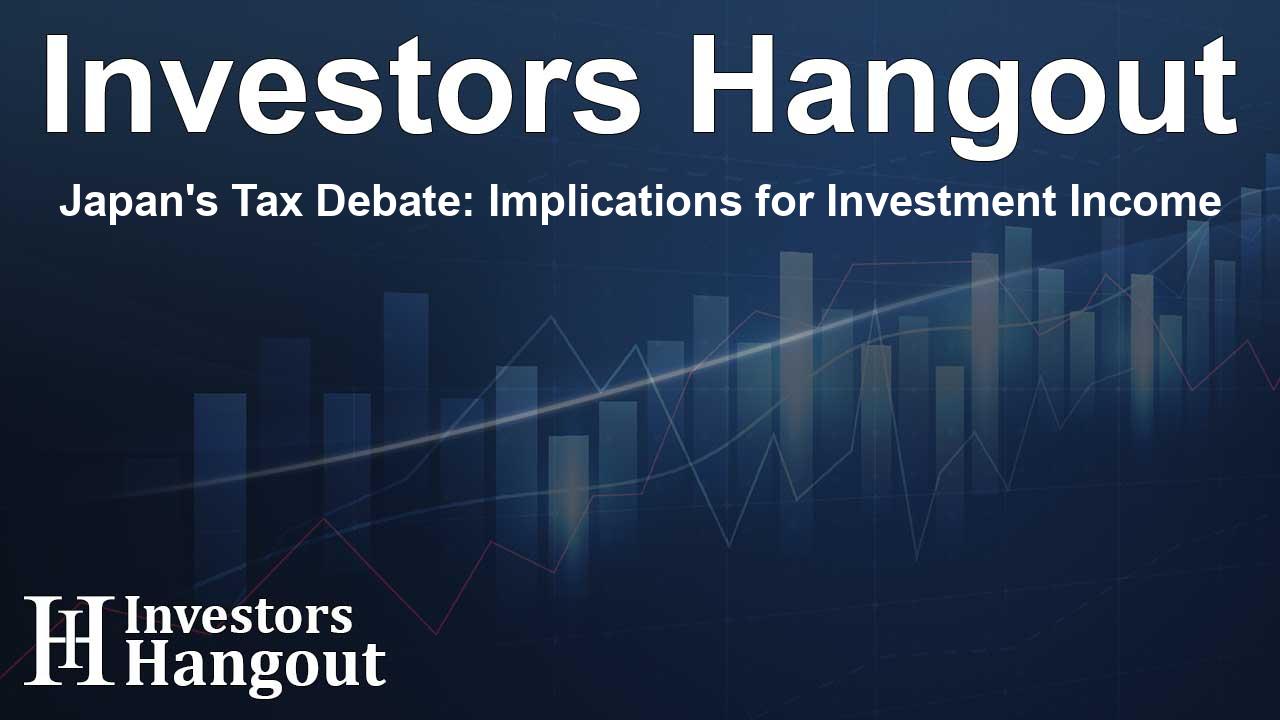Japan's Tax Debate: Implications for Investment Income

Japan's Renewed Tax Debate on Investment Income
In the wake of leadership changes within Japan's ruling party, fresh discussions have emerged about the potential for increasing taxes on investment income. This topic re-emerges as a pivotal subject amid efforts to generate revenue for the nation's extensive budget.
Current Tax Structure for Investments
The existing tax framework for income generated from investments is currently set at a uniform rate of 20%. This encompasses capital gains on both stocks and property, as well as dividends and interest accrued from savings and Japanese government bonds. This steady rate is notably lower than the progressive tax rates on salaries that can reach up to 45%, aiming to promote investment activity within the economy.
Challenges for High-Income Earners
This flat-rate tax model has triggered discussions regarding its implications for high-income earners, who often benefit more significantly from investment returns. The phenomenon is referred to as the "100-million-yen wall," highlighting how tax burdens diminish relative to income for those earning over 100 million yen, which is approximately $698,080.
The Outgoing Government's Position
Raise investment taxes was an ambitious policy agenda proposed by Prime Minister Fumio Kishida upon his election in 2021. His goal was to address wealth inequalities as part of his vision for a "new capitalism." However, political backlash from investors led him to table these discussions, particularly amid fears that such changes would undermine market-friendly policies initiated by his predecessor, Shinzo Abe.
Kishida's Shift in Focus
As Kishida navigated the challenges of his term, including a declining stock market, he pivoted his administration's strategy toward incentivizing household savings into investments. This adjustment aimed to offset rising inflation, leading to the establishment of ongoing tax break initiatives for personal stock investments.
Leadership Race Brings Tax Debate to the Forefront
As Kishida approaches the end of his term, with circumstances arising from years of political scandals, the Liberal Democratic Party (LDP) is set to appoint a new leader and subsequently the next prime minister. Former defence minister Shigeru Ishiba has reignited the conversation about potentially enhancing taxes on investment income, should he secure leadership.
Responses from Political Contenders
Ishiba's statements have stirred responses from other candidates, including Digital Minister Taro Kono and former ministers Shinjiro Koizumi and Takayuki Kobayashi, who contend that increasing these taxes would contradict efforts to motivate citizens to invest rather than save. Ishiba later specified that any proposed tax hikes would only target wealthy individuals.
The Government's Financial Strategy Moving Forward
With approximately 50% of the nation's 2,000 trillion yen in household financial assets currently held in cash or deposits, the government is formulating policies aimed at transforming this landscape. Measures such as the NISA tax-free investment program are part of these strategies to encourage a more investment-oriented public.
Potential Tax Proposals and Future Discussions
If plans for increased investment taxes are officially on the table, they will first undergo scrutiny within the ruling party's tax panel by year's end. The concept is expected to encounter debates, particularly given the junior coalition partner, Komeito's, expressed concerns regarding such increases.
Frequently Asked Questions
What is the current tax rate on investment income in Japan?
The current tax rate on investment income, including capital gains and dividends, is uniformly set at 20%.
Why is there a discussion about raising the investment income tax?
Discussions have surfaced due to the need for increased government revenue to support a large budget, especially with changing political leadership.
What was Prime Minister Kishida's initial position on investment taxes?
Initially, Kishida proposed raising the investment tax rate to address wealth disparities but later shelved the plan amid investor backlash.
How do high-income earners benefit from the current tax structure?
The flat-rate tax system allows high-income earners, who often receive significant returns from investments, to experience a relatively lower tax burden.
What steps is the Japanese government taking to encourage investment?
Policy measures such as the NISA tax-free investment program are being implemented to encourage households to move from cash savings to investments.
About The Author
Contact Hannah Lewis privately here. Or send an email with ATTN: Hannah Lewis as the subject to contact@investorshangout.com.
About Investors Hangout
Investors Hangout is a leading online stock forum for financial discussion and learning, offering a wide range of free tools and resources. It draws in traders of all levels, who exchange market knowledge, investigate trading tactics, and keep an eye on industry developments in real time. Featuring financial articles, stock message boards, quotes, charts, company profiles, and live news updates. Through cooperative learning and a wealth of informational resources, it helps users from novices creating their first portfolios to experts honing their techniques. Join Investors Hangout today: https://investorshangout.com/
The content of this article is based on factual, publicly available information and does not represent legal, financial, or investment advice. Investors Hangout does not offer financial advice, and the author is not a licensed financial advisor. Consult a qualified advisor before making any financial or investment decisions based on this article. This article should not be considered advice to purchase, sell, or hold any securities or other investments. If any of the material provided here is inaccurate, please contact us for corrections.
